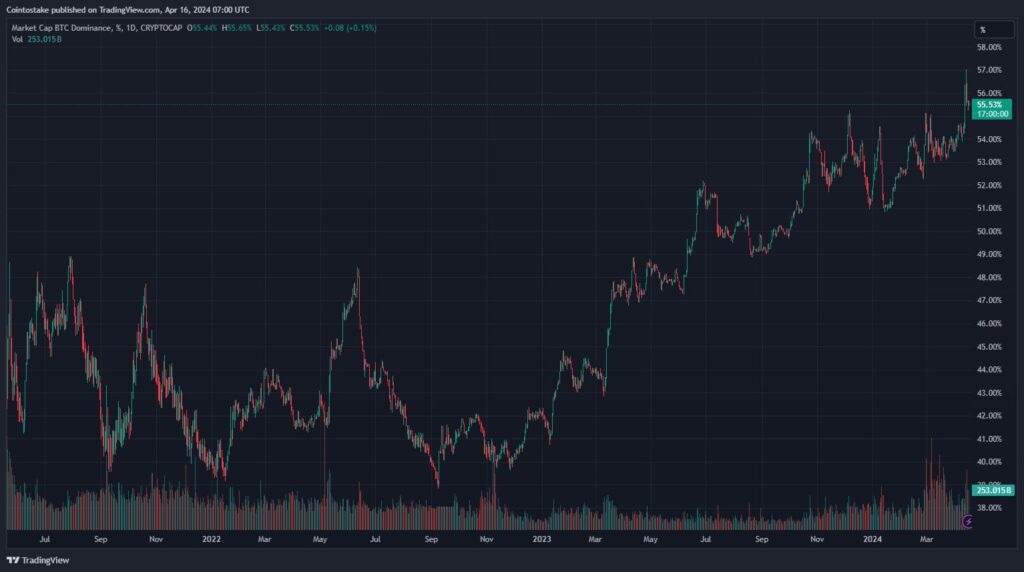
Recent weekend data reveals that Bitcoin’s share in the total cryptocurrency market capitalization has risen to 57.03% as of April 13th. Over the weekend, BTC experienced a drop, with a cascade of liquidations in response to geopolitical conditions driving BTC/USD below $61,000. However, this downturn had a more pronounced effect on altcoins, many of which saw declines exceeding 15% among the top twenty cryptocurrencies by market capitalization.
This retreat by altcoins has contributed to solidifying Bitcoin’s strongest position in the crypto market since April 2021. “I usually don’t pay much attention to dominance, but the chart is impressive considering the number of new altcoins that enter the market every day,” commented popular trader and analyst Bagsy on X.

Hopes for an Altcoin Season Remain Alive
Historically, cryptocurrency bull markets tend to show an initial increase in Bitcoin dominance. Altcoins start to surge as Bitcoin enters a prolonged consolidation phase. For instance, trader Mikybull Crypto believes that alternative coins will soon outpace the premier cryptocurrency in price growth. The accompanying chart compares the dominance of Bitcoin and altcoins, aligning it with the end of 2020 when BTC surpassed its previous all-time high of around $20,000.
Other Articles
Understanding the Impact of Halvings on the BTC Market
Bitcoin’s price history is closely intertwined with its halving events. While debates continue about the direct effect of halvings on Bitcoin’s price, the pattern each cycle follows resembles its predecessors. It’s crucial to recognize that Bitcoin’s price does not operate in isolation. Various macroeconomic factors, such as changes in the money supply, interest rates, geopolitical events, and prevailing market sentiment, can all impact Bitcoin’s price.
Establishing a causal relationship between the halving and Bitcoin’s price movements is challenging. However, the historical reliability of this pattern, along with fundamental aspects of how the network functions, allows for informed inferences about potential outcomes.
Past Halving Events and Their Impact on BTC Price
The primary way Bitcoin halvings impact price revolves around basic supply and demand principles. Fewer Bitcoins being made available should logically lead to a price increase, assuming steady or growing demand. Furthermore, miners have only half as much Bitcoin to sell to cover operational expenses, which reduces selling pressure in the market.
Let’s review how previous halvings have influenced Bitcoin’s price, noting the price of Bitcoin in US dollars at the time of the halving and at the cycle’s peak during the following year:
Halving #1: November 28, 2012
- Block reward reduced to 25 BTC from 50 BTC.
- Price at time of halving: $13
- Following year’s peak: $1,152
- BTC dominance: 98%
Prior to the first halving, Bitcoin was largely unknown outside of the early tech adopters. The price surge from double digits to over $1,000 began to draw media attention, though the digital asset was not widely accepted.
Halving #2: July 16, 2016
- Block reward reduced to 12.5 BTC.
- Price at time of halving: $664
- Following year’s peak: $17,760
- BTC dominance: 90%
The second halving occurred amidst a wave of media scrutiny and coincided with the altcoin and ICO boom, which unfortunately also included numerous scams and failed crypto ventures.
Halving #3: May 11, 2020
- Block reward reduced to 6.25 BTC.
- Price at time of halving: $9,734
- Following year’s peak: $67,549
- BTC dominance: 51%
The third halving took place during the global economic shutdowns of the COVID-19 pandemic. Despite the challenging conditions, the price patterns for BTC/USD mostly adhered to historical trends.
Predictions for the 2024 Bitcoin Halving
The 2024 Bitcoin halving is uniquely positioned as it may coincide with the potential approval of a spot Bitcoin ETF in the United States. Additionally, the context of interest rates could play a crucial role; historically, Bitcoin has performed well in lower-rate environments. Many market analysts believe that the Federal Reserve may begin to cut rates in 2024, potentially boosting Bitcoin’s price.
Final Thoughts on BTC Halving 2024 Price Predictions
Only time will tell which predictions for the 2024 Bitcoin halving will materialize. As always, it’s advisable to conduct your own research, stay informed about the latest industry developments, and invest only what you can afford to lose. The upcoming halving could yet again prove to be a pivotal event for Bitcoin, shaping the market dynamics for years to follow.







